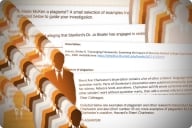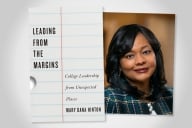You have /5 articles left.
Sign up for a free account or log in.
Dan Rockmore asks a seemingly simple question in the title of collection he has just edited, What Are the Arts and Sciences? A Guide for the Curious (Dartmouth College Press/University Press of New England). But the book is about disciplines, and not just the arts and sciences as a group. Twenty-six of his colleagues at Dartmouth College wrote chapters, explaining their disciplines for the nonexpert. Rockmore, a professor of computer science and mathematics, wrote the chapter on mathematics.
The chapters are of course in some ways minimalist -- biology can't really be explained in 12 pages, nor classics in 13. But the authors each explain a few concepts in their field to illustrate ways of thinking and paths forward for their disciplines. At a time of a lack of appreciation nationally for the arts and sciences, Rockmore hopes the collection will spur better understanding of their importance -- on campus and off. He responded via email to questions about the work.
Q: What gave you the idea of doing this book?
A: The book came from two separate but related ideas. I was enjoying reading E. H. Gombrich’s A Little History of the World to my son -- and learning a lot! And I thought that it would be great if there were an analogous book that was something like a walk through the world of ideas, hopefully written in the same friendly, open and inviting manner for a broader but similarly motivated audience: the curious and eager learner of all ages.
This fed into a related constant little obsession of mine, which is an astonishment around how generally people of all ages have very little understanding or awareness of what it is that others do in their work, be they lawyers, marketing executives or bankers. This is especially true about academics -- just what is it that a math professor does all day? And moreover, even within the academy, it’s true among academics. The art historian may well have no idea of what the sociologist does all day and vice versa. What is it that they are studying?
I’ve devoted a fair amount of time to trying to break down those kinds of walls here at Dartmouth, and this book is a piece of that, but with a broader audience in mind. I’m a firm believer in the idea that most people are generally curious about the world of ideas and that all they need is a nonthreatening and friendly entree, and that we’d all be better off if that curiosity could be embraced, addressed and fostered.
Q: How did you select disciplines and authors?
A: I knew from the start that the book couldn’t be encyclopedic, and I figured I would start from traditional arts and sciences disciplines as a core and then add a bit around the edges, in some sense reflecting the way in which the academy has grown over time. So I had to make some hard choices -- and hope that I didn’t hurt any feelings along the way. For example, even though they are all different disciplines, I wasn’t going to have a chapter on each foreign language, and I chose only French. I chose English and not comparative literature.
There are now many different cultural studies majors, and I chose two of the earliest: African-American studies and women’s and gender studies. Engineering could be a book on its own. After choosing the subjects, I then had to choose among many colleagues for my contributors. I’m lucky to work on a collaborative and small campus where I know a lot of people. Even then I often found myself choosing among friends, many of whom would have done a great job. Dartmouth is known for its fine teachers, so it was an embarrassment of riches and forced some tough decisions.
Q: As you prepared the entry on mathematics, how did you pick the concepts to include?
A: I wanted to give a few examples that would give the reader a flavor for what doing math is all about and also to give an indication of just how broad and grand the discipline is. Math is maybe particularly challenging since some people come to it with some past and not always happy previous experiences. I also wanted to make this gentle introduction example driven -- to help the reader along with little puzzles and then explanations so that she or he could have the experience of actually (and successfully!) doing a little math while reading (no pencil and paper necessary!). Engagement is key. I have three examples there: the first is probably familiar (a famous formula for adding up consecutive numbers); the next probably unfamiliar but understandable, relatable and connected to some very interesting and super-relevant applied work (networks); and the last is really just “math for the fun,” which is the mystery of making sense of infinity.
These examples touch on some central ideas of mathematics: patterns in numbers, topology, infinity, graph theory, but more importantly, I hope that in the explaining they give some idea of what it’s like to do math and shed a little light on the process of abstraction. It’s really just the tip of the iceberg -- but that’s true with every essay. The goal is to give the reader a sense of what the discipline is about, a little insight into how those who engage with it do it and, finally, hope that with that taste, the reader might want to come back for more.
Q: These days, many politicians and parents seem to doubt the value of the liberal arts. Could the ideas in this book be used to change those attitudes?
A: I sure hope so! To start, I guess we need to be a little more precise about the question. For some people “the liberal arts” is code for “the humanities.” When I use the term, I mean the kind of educational context that we still require at Dartmouth -- a broad-based education where you major in a subject but you also require a sampling of course work from the sciences and humanities.
The book is not a polemic. I didn’t ask the authors to say why their discipline matters, but rather to try to answer the question “What is X?” where X is the discipline of choice, as if responding to a curious and interested friend or acquaintance. In this way, the book is like a collection of friendly conversations with a sampling of professors from around campus, and in that a microcosm of the liberal arts environment. I hope that the experience of reading the essays and engaging with the ideas within them generates sparks of excitement, interest and connection -- the same things we aim to inspire when we teach at places like Dartmouth. So that ultimately, the goal would be that a student thinking about a major or course of study, a parent or (even!) a politician -- or any reader -- would have those feelings and then realize that they derive from this collision of ideas. Plutarch wrote that “The mind is not a vessel to be filled, but a fire to be kindled.”
Sometimes when people denigrate the liberal arts, they don’t even really know what it is that they are railing against. People spend a lot of money on college, so it’s reasonable to want to get something tangible out of the experience. Of course, that’s fine for some people and not for everyone. There are all kinds of minds out there. To give a variation on an old cliché, you can teach a person to fish, but you can also teach them about fishing, its history, connection to the environment, its place in different cultures across time, space and even art. The former puts food on the table today, and the latter would probably better for long-term understanding and planning. To the extent that you need a value proposition, both approaches have value, intellectually and in the marketplace. But of course I’m not the only person saying that -- even business magazines talk about the value of the liberal arts.
Q: Of the entries that you didn’t write, were there one or two that surprised you? How?
A: So, just to be clear, I only wrote the math entry. Twenty-six of my colleagues (OK, two are now former colleagues) wrote the others! I learned so much by reading and editing the essays.
You put me in a tough spot by asking me to pick one or two, but I’ll try. I suppose that the essay that I learned the most from was Derrick White’s contribution, “What Is African-American Studies?” I only had some vague sense of the field, and Derrick does an extraordinary job in his essay of articulating the importance and subject matter of the discipline, discussing its origins, all while surveying some of the enduring subjects of study within it. I found it to be extraordinarily inspiring and thought provoking. Ada Cohen’s essay “What Is Art History?” is also a favorite. I am forever amazed at how much can be learned by looking closely at a work of art or, for that matter, any kind of image or object and am in awe of those who can read a painting like I read a book or an equation.








